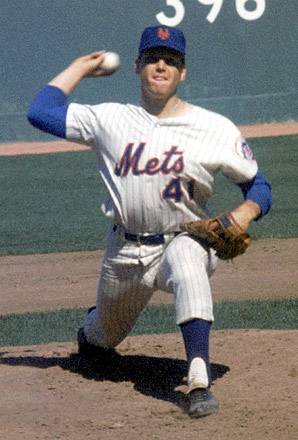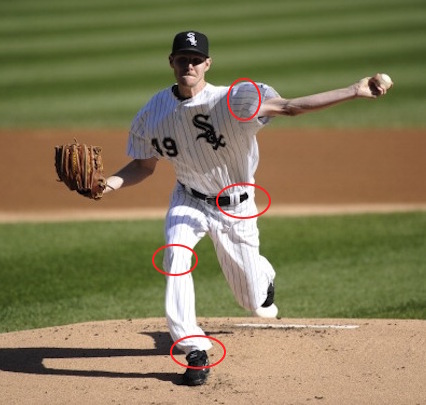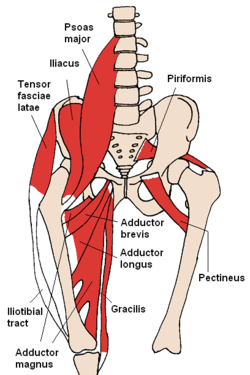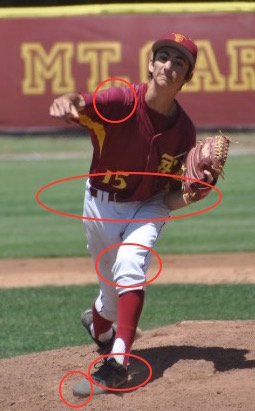Effect of Groin (adductor) Tightness in Baseball Players
If you have ever played baseball, or really any rotational sport, you have experienced some type of groin pain. You have probably had tightness, you may have felt pulls, and you have lost time within your craft because of it. What most don’t know are the actual causes for the issues, the impact it has elsewhere in your body, and easy ways to relieve nagging groin issues. That’s where this article comes in!

Groin Tightness in Baseball
Groin tightness, also known as adductor tightness, is as common, if not more common than shoulder issues within the baseball and overhead athlete community. The common trend to take care of these issues is to stretch your groin (think groiners and the butterfly stretch) and maybe develop some strength through your glutes with a clam shell or other glute specific exercise. This common protocol might bring temporary relief, but nothing that will actually stick and have a positive impact on performance. To see what really works we need to start with a little deeper understanding of how the adductors work and what is causing the tightness.
What are the Adductors
The adductors are a group of muscles that include the adductor magnus, brevis, longus, the iliopsoas, TFL, obturator, and tensor fascia latae. Together, the anatomical function of these muscles is internal rotation of the femur, hip flexion, lateral rotation, and adduction. To look a little deeper, this muscle complex is dependent upon the co-activation of your hip extensors, abductors, and external rotators of the pelvis. This means that if your glutes aren’t firing effeciently, your adductors might kick on to pick up the slack.
Looking a little deeper, your adductors play a critical role in efficiently loading your oblique sling. Loading this sling of musculature properly, with great joint position is critical in terms of maintaining proper throwing mechanics.
Moving forward, it’s important to realize that no movements within your body are completed by a sole group of musculature. Movement is a dynamic process, and is often over simplified by taking a single joint approach to a problem. For example, pitching requires the adductors of your driving leg to firing concentrically to generate force towards home plate. The ability to do so, and with control, is dependent on your abductors ability firing eccentrically, while they assist in decelerating the movement. Once the ball is released and you cross the midline of your body, the roles are immediately reversed, and your adductors fire eccentrically while the abductors fire concentrically to decelerate and stop the movement.
This reaction happens at every joint within your body. It comes down to Newton’s 3rd law; for every action there is an equal and opposite reaction. Ideal deceleration is a gross movement and carried out by our entire body. This means, in order to decelerate properly we need ideal joint centration and stabilization of the opposing and supporting musculature. Sadly, this is not always the case. When it’s not, other muscles, tendons, and ligaments, have to pick up the slack… and this is where overuse injuries occur.
Dissecting the Cause in Baseball Players and overhead athletes
99.999% of the time, the tightness in your adductors is a result of a loss of co-activation between your adductors and hip external rotators and extensors, stemming from a faulty movement pattern. Basically your adductors are trying to pick up the slack, creating stabilization, trying to generate force, and decelerating the force at the same time. Tightness and over activation here can single handily force you into lateral side bending, and decentrate the entire movement.
Why this Movement Pattern
The movement patterns we create are a direct result of our sports, coaching, and structural anatomy. Since we can’t take an MRI or x-ray of every athlete that walks through the door, we can’t put much thought into the effect of one's anatomical structures, because honestly, we can’t change that.
In terms of coaching and movement demands of the sport, we can do a lot to figure out the cause for the adductor issues. At 1RM Performance we start by talking to an athlete to paint a picture for the cause. Next, we move to a pseudo Functional Movement Screen with DNS accents to see the effect of the issue on gross movement patterns, and follow that up with a few DNS screens to see the deeper cause for the issue.
To see the effect it has in action, let’s take a look at a pitcher who I know for a fact suffered from adductor issues. (i know this because he is one of my athletes.) The effect it has on his movement patterns are consistent with any over head athlete who has developed groin tightness.
The picture above is of one of my athletes when he first started training a year ago who threw in the low 70s. If you look at his front leg, you see a valgus collapse in his front knee, you see his ankle internally rotating, and you see his back hip driving hard, sort of collapsing, into his front hip and leaning to the left. At the pelvis and trunk you see lateral side bending and a loss of centration through his shoulders. This movement pattern inhibits his ability to rotate over his front foot, specifically over the first joint of his big toe, inhibiting his ability to load his oblique sling.
In terms of throwing, this decreases his velocity, his ability to locate pitches, his ability to generate force, and forces deceleration onto passive structures of his body. This is a classic look at cause and effect of an athlete who has, or is currently developing adductors issues.
Effect on Training
In terms of training, it took weeks to actually see a clean squat pattern. It took weeks to actually bench without his left shoulder (think front shoulder decentration as a result of adductor tightness) shifting to a decentrated position. It was a headache. I could have easily said F this and threw him under the bar, but that’s not my way of doing things. I address a problem and fix it. And if I can’t fix it, I know someone who can. But I digress... You could only imagine my celebration when we were actually able to squat, with great loading through his entire supporting structure, not just his quads, lower back, and adductors.

If we Evan to my boy Tom Seaver, we can see the difference in mechanics. If you don’t know Tom Seaver, he is one of the greatest pitchers of all time. His success is derived from his nearly flawless mechanics. His mechanics are so pure that they actually hold true to the DNS standard of joint centration. Looking at Tom Seaver, you see his front foot pointing directly to home plate, his shoulders are level, his pelvis is level, nearly perfectly centrated throwing mechanics. The result of this is 24 years in major league baseball, 314 career wins, a career 2.86 ERA, and most importantly an injury free career.
It’s hard to say we will ever see someone like this again.
More often than not, I see athletes that come in more like the athlete listed above. But this doesn’t mean that hope is lost. This young man improved his velocity by 3 or 4 mph after his second day, simply because of the changes we began making within his deep stabilizing system, improving his ability to stabilize and support through his front side. This past summer he squatted 310 weighing 150 soaking wet, continues to move better, has no adductor tightness, and he and his brother are part of my growth and continuing understanding as a strength coach.
Here is that young man today versus a year ago. Notice the difference in his front foot, front knee, glove hand, shoulder positioning, levelness through his pelvis, and levelness through his shoulder. The difference is a 11 mph increase in his throwing velocity, no back pain, no shoulder pain, and an absolute love of training.

Yes, there are pitchers who are exceptions to the rules of ideal movement. Enter Chris Sale here! They are the .0001 percent that make it to the bigs. Those that do, have other anatomical abnormalities that allows them to get away with not so ideal compensatory movement patterns. Their bodies might not be able to hold up long enough to be a 300 game winner, but they could certainly be successful.

Everyone knows that throwing a baseball, especially pitching, is an unnatural movement. Throwing a baseball as often as kids do today, with poor mechanics is even more unnatural. This pattern, if you are not a master compensator with anatomical abnormalities, can change every movement pattern within your nervous system, yes, that includes your squat, bench, deadlift, sprint mechanics…everything
The fix
Asking a kid to do something he currently can’t do is unfair. Suddenly changing an athletes movement pattern WILL result in a compensation elsewhere or an immediate strain. Take my word for it. Athletes, especially high-level athletes, are master compensators. If you see the desired moved, beware that it might be do to a new poor movement elsewhere. Remember to view the body as a dynamic unit, not just as a single joint.
Fixing mechanics isn’t as easy as just instructing an athlete to get his foot towards home and stay level through the pelvis and shoulders. If an athlete has lost the movement and stabilization pattern, we have to start there. This often starts by re-establishing the deep stabilizing system through breathing and Intra Abdominal Pressure. Once we do this, we move through specific DNS developmental movement patterns that recreate ideal movement patterns, re=establishing stabilization and mobility at fundamental levels. From there its carrying out the ideal patterns and joint positions with load.
To fix the pattern, we fix the computer, and in our bodies, the computer is our brain. Understanding that adductor issues don’t only affect your groin will allow you to ultimately fix more then you realize. When I first began working with pro baseball players I was amazed by the things I was able to link together. Most pertinent to this article is the restriction adductors created on an athlete’s ability to rotate into their front hip, and front shoulder. The two are definitely linked to scapular instability and decentration within the front shoulder. This ultimately strips them of stabilization, throwing velocity, and power in their swing.
I would not have ever been able to link the two if I just looked at a hip as a hip, and paid no attention to joints else where during the movement pattern.
Here at 1RM Performance I correct issues by blending DNS and fundamental training movement patterns. So far this has worked wonders on improving adductor tightness and re-establishing the ideal co-activation relationship between your adductors and surrounding hip musculature. Not to mention correcting other faulty patterns along the way.
The results of this approach are pretty awesome. Every athlete reports back saying throwing hard becomes effortless. These are the exact words from 7 of my pitchers who have dealt with adductor and other movement issues.
I am a strength coach, and DNS is not all that I do. However, it is one of the most powerful tools there is to correct movement patterns. It’s only another tool in my toolbox. I blend DNS with strength and conditioning.
Here are the movements I have found to be most useful at correcting adductor tightness.
It is important to note that the cuing and joint positioning of the movements are is what makes them powerful and each one leads to the next. Its like squatting, you cant squat 500 if you don’t squat 400. And you cant squat 400 without first squatting 300. It’s all about progression.
Deep stabilizing
5 months to 7 months
https://www.youtube.com/watch?v=e8dS8rGhmGM
4.5 month prone
https://www.youtube.com/watch?v=qxOe2hI5gvk
8.5 months with rotation
https://www.youtube.com/watch?v=bA-9EcUzoqc
half kneeling with rotation
https://www.youtube.com/watch?v=z-pjDVN8NTo
half kneeling with rotation and row
https://www.youtube.com/watch?v=kJsdOYcA0hQ
Stand med ball throw with rotation
https://www.youtube.com/watch?v=1FotMdCN6Bk
Adductor tightness sucks. It can single handily change every movement within your body, whether it’s throwing, squatting, benching, sprinting, jumping, or deadlifting. But this doesn’t mean it can’t be fixed. At first, my athletes struggle through the movements shown in the videos above. They are complicated and hard when done properly. But in time (honestly seconds), our brain begins to recognize the movement, we regroove the pattern, and we get better.
The exercises listed above all have benefits greater than just correcting adductor tightness, as focused in this article. Some athletes go through the movements once and feel better right away (movement savants, young athletes) while others need constant work to maintain some level of ideal movement. If you don’t like the sound of that, just think about how many years it takes to establish your poor movement patterns. You could spend 6 minutes before a workout to try and fix 16 years of crap movement; it isn’t that hard. Your body, brain, and numbers in the gym will thank you for it.
Although a lot of what is mentioned is considered soft training, and thing are written about movement, I am a strength coach, and I use everything written in here to get my kids to be able to train hard. That is the ultimate goal with every single person that walks into my gym doors.

